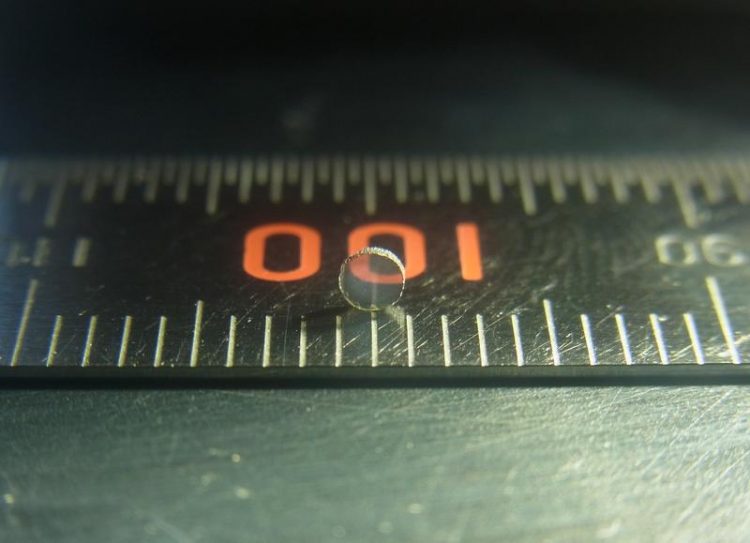Transparent ceramics make super-hard windows

This is a sample of transparent polycrystalline cubic silicon nitride with a diameter of approximately two millimeters, synthesized at DESY. Credit: Norimasa Nishiyama, DESY/Tokyo Tech
Scientists have synthesised the first transparent sample of a popular industrial ceramic at DESY. The result is a super-hard window made of cubic silicon nitride that can potentially be used under extreme conditions like in engines, as the Japanese-German team writes in the journal Scientific Reports.
Cubic silicon nitride (c-Si3N4) forms under high pressure and is the second hardest transparent nanoceramic after diamond but can withstand substantially higher temperatures.
“Silicon nitride is a very popular ceramic in industry,” explains lead author Dr. Norimasa Nishiyama from DESY who now is an associate professor at Tokyo Institute of Technology. “It is mainly used for ball bearings, cutting tools and engine parts in automotive and aircraft industry.”
The ceramic is extremely stable, because the silicon nitrogen bond is very strong. At ambient pressures, silicon nitride has a hexagonal crystal structure and sintered ceramic of this phase is opaque. Sintering is the process of forming macroscopic structures from grain material using heat and pressure. The technique is widely used in industry for a broad range of products from ceramic bearings to artificial teeth.
At pressures above 130 thousand times the atmospheric pressure, silicon nitride transforms into a crystal structure with cubic symmetry that experts call spinel-type in reference to the structure of a popular gemstone. Artificial spinel (MgAl2O4) is widely used as transparent ceramic in industry. “The cubic phase of silicon nitride was first synthesised by a research group at Technical University of Darmstadt in 1999, but knowledge of this material is very limited,” says Nishiyama.
His team used a large volume press (LVP) at DESY to expose hexagonal silicon nitride to high pressures and temperatures. At approximately 156 thousand times the atmospheric pressure (15.6 gigapascals) and a temperature of 1800 degrees Celsius a transparent piece of cubic silicon nitride formed with a diameter of about two millimetres. “It is the first transparent sample of this material,” emphasises Nishiyama.
Analysis of the crystal structure at DESY's X-ray light source PETRA III showed that the silicon nitride had completely transformed into the cubic phase. “The transformation is similar to carbon that also has a hexagonal crystal structure at ambient conditions and transforms into a transparent cubic phase called diamond at high pressures,” explains Nishiyama. “However, the transparency of silicon nitride strongly depends on the grain boundaries. The opaqueness arises from gaps and pores between the grains.”
Investigations with a scanning transmission electron microscope at the University of Tokyo showed that the high-pressure sample has only very thin grain boundaries. “Also, in the high-pressure phase oxygen impurities are distributed throughout the material and do not accumulate at the grain boundaries like in the low-pressure phase. That's crucial for the transparency,” says Nishiyama.
“Cubic silicon nitride is the hardest and toughest transparent spinel ceramic ever made,” summarises Nishiyama. The scientists foresee diverse industrial applications for their super-hard windows. “Cubic silicon nitride is the third hardest ceramic known, after diamond and cubic boron nitride,” explains Nishiyama. “But boron compounds are not transparent, and diamond is only stable up to approximately 750 degrees Celsius in air. Cubic silicon nitride is transparent and stable up to 1400 degrees Celsius.”
However, because of the large pressure needed to synthesise transparent cubic silicon nitride, the possible window size is limited for practical reasons. “The raw material is cheap, but to produce macroscopic transparent samples we need approximately twice the pressure as for artificial diamonds,” says Nishiyama. “It is relatively easy to make windows with diameters of one to five millimetres. But it will be hard to reach anything over one centimetre.”
###
Tokyo Institute of Technology, Ehime University, the University of Bayreuth, Japanese National Institute for Materials Science, and Hirosaki University were also involved in this research.
Deutsches Elektronen-Synchrotron DESY is the leading German accelerator centre and one of the leading in the world. DESY is a member of the Helmholtz Association and receives its funding from the German Federal Ministry of Education and Research (BMBF) (90 per cent) and the German federal states of Hamburg and Brandenburg (10 per cent). At its locations in Hamburg and Zeuthen near Berlin, DESY develops, builds and operates large particle accelerators, and uses them to investigate the structure of matter. DESY's combination of photon science and particle physics is unique in Europe.
Reference
“Transparent polycrystalline cubic silicon nitride”; Norimasa Nishiyama et al.; Scientific Reports, 2017; DOI: 10.1038/srep44755
Media Contact
All latest news from the category: Materials Sciences
Materials management deals with the research, development, manufacturing and processing of raw and industrial materials. Key aspects here are biological and medical issues, which play an increasingly important role in this field.
innovations-report offers in-depth articles related to the development and application of materials and the structure and properties of new materials.
Newest articles

A ‘language’ for ML models to predict nanopore properties
A large number of 2D materials like graphene can have nanopores – small holes formed by missing atoms through which foreign substances can pass. The properties of these nanopores dictate many…

Clinically validated, wearable ultrasound patch
… for continuous blood pressure monitoring. A team of researchers at the University of California San Diego has developed a new and improved wearable ultrasound patch for continuous and noninvasive…

A new puzzle piece for string theory research
Dr. Ksenia Fedosova from the Cluster of Excellence Mathematics Münster, along with an international research team, has proven a conjecture in string theory that physicists had proposed regarding certain equations….



